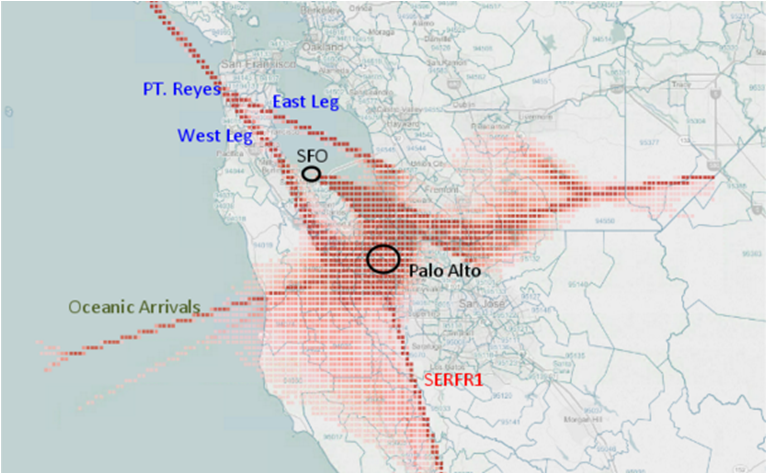13 Specific Recommendations for FAA Consideration
List of 13 Specific Recommendations SPPA Offers for FAA Consideration
 We have the rare opportunity to fix this problem properly. Let’s take advantage of it. Below are listed 13 specific suggestions Sky Posse has submitted to the FAA. They are available with illustrations and references here.
We have the rare opportunity to fix this problem properly. Let’s take advantage of it. Below are listed 13 specific suggestions Sky Posse has submitted to the FAA. They are available with illustrations and references here.
1) Abandon the use of the MENLO way point.
A 4000-foot way point over a densely populated area is unacceptable, unsustainable, and unnecessary when a huge body of water is directly available less than 2 miles away. Adopt one or more way points east or southeast of MENLO to enable arrivals to fly at higher altitudes over residential areas and take full advantage of the length of the Bay.
2) Direct Pt Reyes arrivals to use primarily the Pt Reyes east leg (over the Bay) for immediate relief.
Then address, if necessary, the concentration issue of low altitude Pt Reyes west leg arrivals over Palo Alto. Take advantage of the full extent of the Bay for descents. Guide arrivals from the south up the uninhabited or industrial areas east of the Santa Clara Valley/US 101 so that planes avoid residential areas.Then guide arrivals through one or both traffic gaps as shown in figure 2 to get to the Bay for final approach.
3) Take advantage of the full length of the Bay by approaching from the southern shore of the Bay.
Scenario modeling should be done to identify the optimal path that would maximize altitudes over populated areas. Given that the distance to SFO, including industrial areas north of US 101, would be at least 23 nautical miles, planes could remain at high altitudes over populated areas. As a result, airplane noise may barely be noticeable over ambient noise levels.
4) Use the highest possible angle of descent.
The current angle of 2.85° is quite conservative. Heathrow currently uses 3° but the aviation industry has determined that Heathrow could use 3.2° for its existing runways and a proposed new runway in 2030; according to Heathrow, 3.5° would be feasible by 2040. The Frankfurt airport is already using a 3.2° Hannover, Germany is testing 4.5°.
5) Route night traffic over the full length of the Bay.
SFO departures should not have exclusive use of the full length of the Bay at night, which forces night arrivals over mid-peninsula residents. The low volume of SJC air traffic at night should allow SFO approaches from the south end of the Bay.
6) Sequence planes over the ocean or unpopulated areas, but not over residential communities to minimize the frequency of disruptions that impact the health and well-being of residents.
7) Fix unstable descent and low altitude vectoring, level flying, and speed changes which are noisy and fuel inefficient.
8) Consider a ‘herringbone’ or ‘trident’ approach pattern to reduce concentration over populated areas.
This is apparently feasible in Great Britain. It would take advantage of the full capability of NextGen while providing fair distribution of noise.
9) Address SJC operations that impact the residential areas of the mid-peninsula.
SJC tends to go on reverse flow much more often than SFO. When in reverse mode, SJC arrivals now overfly Palo Alto at 2000 feet while crossing arriving SFO flights above Palo Alto. SJC has regular oceanic departures over Palo Alto that thread under flights that are arriving on SERFR and other routes.
10) Require airlines to install vortex generators on A320 family planes.
This inexpensive fix (estimated at $5,000 by the SFO noise abatement office) would go far in creating community good will.
11) Use modeling tool (AEDT 2b) to evaluate noise impact and dispersion of air pollutants for various alternatives.
12) Integrate noise abatement planning between SFO and SJC given that treating them as separate airports greatly diminishes options to reduce noise.
13) Implement a continuous improvement program to reduce noise and emissions over heavily populated communities.
